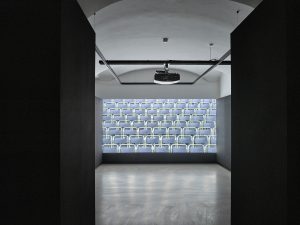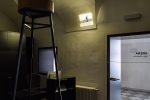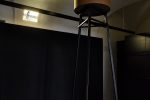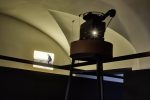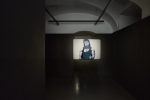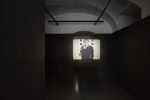ARENA
Björn Kämmerer
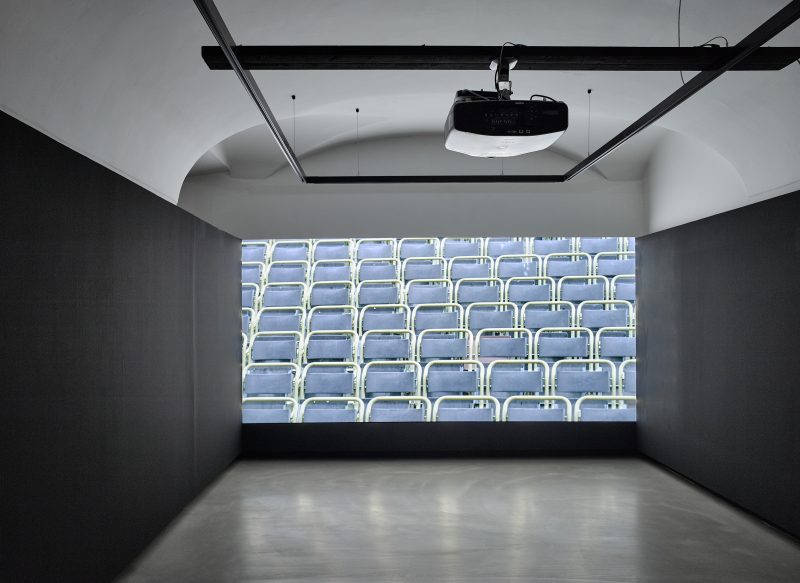
Björn Kämmerer’s films start out from the everyday, the supposedly normal, and rob the motifs of their function. He enters personally into the role of the viewer, and despite the great familiarity of the elements on the cinematic stage, a focus on abstraction and close-ups leads to confusion but also to innovative viewing angles. It is by this means that he subsequently challenges the medium of film and the watcher’s viewing habits. “Is it an abstract painting, or a film after all?” visitors might ask themselves if the camera or the viewing grandstand turned in his latest piece, ARENA, conceived as a 70mm film.
One aspect of works by Björn Kämmerer is their quality of bringing film and architecture into dialogue. This is perceptible immediately on entering the gallery space. Our view is directed upwards. On closer examination, what appeared at first glance to be a sculpture becomes the base for a revolving 16mm projector, which directs images onto the walls. On the one hand, the sculpture, its dimensions adjusted to fit the gallery space, stages the mechanics of the apparatus; on the other hand it produces the 360 degree projection. The movement of light defines and alters the projected image in relation to distance and the angle of projection onto the wall. The image disappears and blurs briefly only to reappear on the next wall. The subject is a cyclist, the artist himself, who is riding back and forth in front of a wall, sometimes travelling backwards. Filmed on an uninhabited island in the Baltic, the image expands the projection’s trajectories into the space and to the horizon of the sea, while the artist endlessly riding his bike moves with and against the rotation of the image.
The short REMOTE/8 shown in an endless loop is reminiscent of the beginnings of the film genre, when images were just learning to move. Björn Kämmerer relates his film installation to architectonic and cinematographic space.
In the next room Björn Kämmerer shows his latest film work, ARENA. This is a digital version of a 70mm film, the original version of which will be shown on the opening evening at the Leokino in Innsbruck. “The concept of the arena points to the genius loci: the place in which a competition was staged, and therefore the promise of a spectacle was redeemed. This “Arena” remains concealed in Björn Kämmerer’s film. Or rather, it is the subject of a definition of location. For rather than directing our attention to the oval, the stage or other promises Kämmerer focuses on the audience space – grey, unoccupied seats, row upon row, in an outdoor stadium.
The chief attraction here: our view of the audience block is dynamized, even twofold. While the camera moves backwards at a snail’s pace, slowly moving away, therefore, the rows of seats move in a circular fashion. The effect is less obvious than when using a dolly-zoom, when only the background changes. The gradual expansion of our field of vision, the enlargened picture section, includes a comparable indefinable aspect, however. The creeping motion becomes an attraction in itself.
“In his films Kämmerer repeatedly translates filmic processes or forms into ingenious experimental setups, which place the viewer in a spatially and sensually destabilizing position. […]The rows of seats, for example, are framed in such a way that few points of orientation remain: more and more rows can be seen, certainly, but the image does not open into the outside world, it remains consistent within the order of its own elements.
Kämmerer’s ARENA is conceived as a 70mm film, a format predestined for the dramatic as a result of its enormous aspect ratio, and also particularly suited to horizontal motion. As a clever study in extension, it presents itself here as the essence of a graphic image, an image that grows but from which nothing emerges. ARENA does not focus on the spectacle of visibility but on the space of the viewer and the cinema, and therefore on apparatuses as collaborators.” (Dominik Kamalzadeh)
When visitors to the exhibition turn their attention away from the arena, they are blinded by a dazzling light. This is followed by a black screen with cross hairs at the centre. The association with first person shooter games is not coincidental: for fragments of a second, shooting range figures with pistols in their hands appear, standing or kneeling. It seems to be a random collection of stereotypes from US-American gangster films. The title of the film work, TRIGGER, also plays with the double meaning of the term – as the trigger of a weapon or of a camera. To make this, Björn Kämmerer selected “protagonists” from 150 so-called “training targets” of a company in Minnesota that produces training products for executive organs; he filmed them on 35mm in South California and mounted them into a cinematic stroboscope with overexposed initial images. In the Neue Galerie he is showing the film in a 16mm projection.
Björn Kämmerer stages a cinematic experience comprising several chapters in the gallery space, its dynamic dramaturgy encapsulating the visitors.
